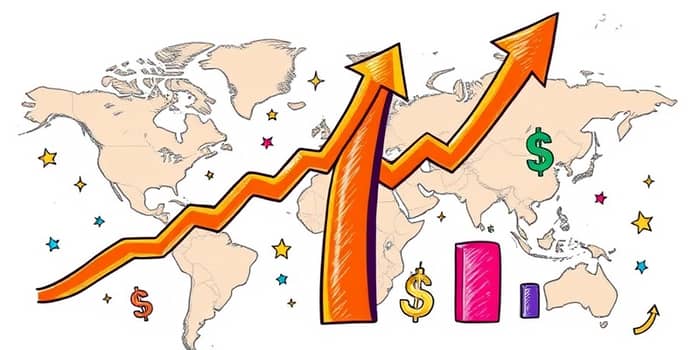
As of July 1, 2025, government bond markets are facing renewed volatility as investors wrestle with persistent inflation risks and fiscal uncertainties. Yields on benchmark Treasuries continue to climb, reshaping the landscape for governments, corporations and individual savers. Decision-makers and market participants alike are watching each data release closely, aware that small shifts in expectations can translate into significant moves in global borrowing costs.
The U.S. 10-year Treasury yield jumped to 4.28% at the start of July, up 0.05 percentage point from the previous session, and had earlier reached 4.39% by June 27. Longer maturities also surged: the 30-year Treasury ended June 27 at 4.85%, while the 2-year yield climbed to 3.30%. These moves follow a 24 basis-point rise in May that drove the 10-year yield to 4.42%.
Across the Pacific, Australia’s 10-year government bond yield rose 19 basis points to 4.25% at month-end. In Japan, the 10-year yield surged nearly 20 basis points to 1.51%, while ultra-long 30- and 40-year JGBs hit record highs of 3.16% and 3.67%, respectively, as international investors reassess risk premia.
While the absolute levels remain well below historical peaks—U.S. 10-year yields hit a 15.8% high in September 1981—the current trajectory signals a meaningful shift from the ultralow rate environment of recent years.
Inflation fears lie at the heart of this sell-off in bonds. Although the U.S. consumer price index eased to a 2.3% year-on-year gain in April—the lowest since February 2021—persistent inflation worries remain a concern for policymakers. Federal Reserve officials have repeatedly cautioned that upside risks to prices have not fully abated, especially given recent fiscal stimulus and ongoing supply chain disruptions.
Some analysts warn of a potential drift toward stagflation, where rising prices erode economic growth. This scenario is heightened by trade tensions that could inflate import costs, while government spending may boost demand without a commensurate rise in output. Policymakers now face the delicate task of reigning in price pressures without triggering a downturn.
On the fiscal front, market participants are uneasy about the latest tax-and-spending bill proposed by the administration. Estimates suggest the plan could widen the U.S. budget deficit faster than previously forecast, adding pressure on long-term borrowing costs. In late June, Moody’s downgraded the U.S. credit rating, citing weakening governance around fiscal management and growing debt burdens.
Investors now demand a higher risk premium to hold government debt over extended horizons. This shift reflects an acute sensitivity to fiscal sustainability and underscores concerns that unchecked deficits could eventually spark higher global interest rates and inflation.
Despite rising yields, market consensus still points to two quarter-point rate cuts from the Fed by year-end, likely in September and December. However, shorter-term rate easing may not fully offset the upward pressure on long-term yields driven by ongoing inflation pressures and risks.
Global central banks are charting diverse paths: the Bank of Japan maintains its ultra-accommodative policy yet sees higher bond yields, while the Reserve Bank of Australia has trimmed rates but still confronts rising yields. These mixed signals highlight a broader reassessment of inflation risk premiums worldwide.
Bond yields plunged during the depths of the COVID-19 shock as investors flocked to safe havens, but they have since rebounded sharply. The yield curve, particularly the spread between 10- and 2-year Treasuries, remains the most closely watched recession indicator. An inversion of this “10-2 spread” has historically preceded economic downturns.
Today’s curve remains largely upward-sloping, but the gap has narrowed, prompting speculation about potential growth slowdowns. Policymakers and analysts are vigilant: any sustained inversion could heighten recession fears and further elevate market volatility.
Higher yields have restored some allure to government debt after years of near-zero returns. For risk-averse investors, bonds now offer more attractive income streams, reshaping portfolio allocations and valuations in other asset classes. Inflation-linked products have also drawn interest: the U.S. I Bond composite rate was set at 3.98% for May–October 2025, reflecting ongoing inflation pressures baked into their structure.
Nonetheless, rising borrowing costs pose challenges for corporate issuers and households. Mortgage rates have climbed, and corporate bond spreads are adjusting to the new risk environment. Central to investor strategies now is balancing income objectives with duration risk and inflation hedging.
With government bond yields poised to fluctuate around multi-year highs, both institutional and retail investors must adapt. Diversification across maturities and geographies can mitigate localized risks, while exposure to inflation-protected bonds like I Bonds offers a hedge against further price accelerations. Short-duration strategies may also help guard portfolios against volatility in long-term rates.
For policymakers, the challenge remains maintaining credibility in the fight against inflation without stifling growth. Ongoing communication, clear guidance on future rate paths, and prudent fiscal management will be crucial to anchoring expectations and stabilizing financial markets.
As markets navigate this new reality, bond yields will continue to serve as a barometer of economic sentiment, policy confidence and risk appetite. The current upswing underscores a broader transition away from the low-rate paradigm of recent years and marks a critical juncture for global finance.
References













